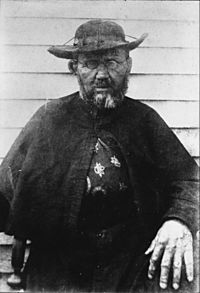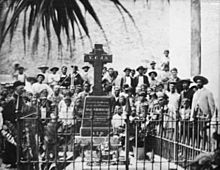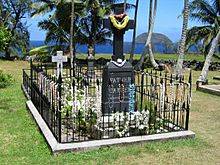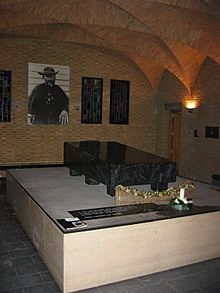Father Damien facts for kids
Quick facts for kids SaintDamien of Molokai SS.CC. |
|
|---|---|

A photograph of Father Damien taken shortly before his death
|
|
| Religious Priest and Missionary | |
| Born | 3 January 1840 Tremelo, Brabant, Belgium |
| Died | 15 April 1889 (aged 49) Kalaupapa, Molokaʻi, Hawaiʻi |
| Venerated in | Roman Catholic Church, Eastern Catholic Churches, some churches of Anglican Communion; individual Lutheran Churches |
| Beatified | 4 June 1995, Basilica of the Sacred Heart (Koekelberg), Brussels, by Pope John Paul II |
| Canonized | 11 October 2009, Vatican City, by Pope Benedict XVI |
| Major shrine | Leuven, Belgium (bodily relics) Molokaʻi, Hawaii (relics of his hand) |
| Feast | 10 May (Catholic Church; obligatory in Hawaii, option in the rest of the United States); 15 April (Episcopal Church of the United States) |
| Patronage | People with Leprosy |
Father Damien (born Jozef De Veuster), also known as Saint Damien of Molokai, was a Catholic priest from Belgium. He was a member of a group called the Congregation of the Sacred Hearts of Jesus and Mary.
Father Damien is famous for his work from 1873 until his death in 1889. He helped people with leprosy (also called Hansen's disease) in the Kingdom of Hawaiʻi. These people lived in a special settlement on the Kalaupapa Peninsula of Molokaʻi.
He taught the Catholic faith to the people there. Father Damien also cared for the sick. He helped build houses, schools, roads, hospitals, and churches. He even dressed wounds, made coffins, and dug graves. He truly lived among the people he served.
After 11 years of caring for the community, Father Damien himself got leprosy. He kept working despite his illness. He died on 15 April 1889. He is honored as a saint in the Catholic Church. Many other Christian groups also see him as a special helper for those with leprosy and for outcasts. In Hawaii, April 15th is a holiday called Father Damien Day.
Father Damien was made a saint by Pope Benedict XVI on 11 October 2009. He is sometimes called "the Apostle of the Lepers." His feast day is celebrated on May 10th.
Contents
Father Damien's Early Life
Father Damien was born Jozef De Veuster on January 3, 1840. He was the youngest of seven children. His family lived in a small village called Tremelo in Belgium.
His older sisters became nuns, and his older brother, Auguste, became a priest. Jozef had to leave school at 13 to work on the family farm. Later, his father sent him to college to learn about business. But in 1858, Jozef decided he wanted to become a priest.
Jozef joined the Fathers of the Sacred Heart of Jesus and Mary. He took the name Damien, after an early Christian saint. His leaders thought he might not be smart enough to be a priest because he didn't have much schooling. However, he learned Latin well from his brother. So, they allowed him to continue his studies.
During his studies, Damien prayed every day to be sent on a mission. Three years later, his brother Auguste got sick and couldn't go to Hawaiʻi as a missionary. Damien was allowed to take his place.
His Mission in Hawaii
On March 19, 1864, Damien arrived in Honolulu Harbor in Oʻahu, Hawaii. He became a priest on May 21, 1864.
In 1865, Father Damien was sent to a Catholic mission on the island of Hawaiʻi. At that time, the Kingdom of Hawaiʻi faced a big health problem. Many Native Hawaiian people were dying from diseases like leprosy, smallpox, and cholera. These illnesses were brought to the islands by foreign traders and sailors. Hawaiians had no natural protection against them.
Leprosy (Hansen's disease) was thought to be very contagious and had no cure. In 1865, the Hawaiian King Kamehameha V made a law to stop the spread of leprosy. This law meant that people with serious cases of leprosy had to move to a special settlement. This settlement was on the Kalaupapa peninsula of Molokaʻi. From 1866 to 1969, about 8,000 Hawaiians were sent there.
The Kalaupapa peninsula is cut off from the rest of Molokaʻi by a steep mountain. The government tried to provide food and supplies. However, they didn't have enough people or resources to offer good health care. The government hoped the people could care for themselves. But because of their illness and the land, this was very hard.
Helping the People of Molokai
The bishop of Honolulu believed the people with leprosy needed a priest. He knew it was a dangerous job. Four priests volunteered, and Father Damien was the first to go. The plan was for them to take turns helping the community.
On May 10, 1873, Father Damien arrived at Kalaupapa. There were about 600 people with leprosy living there. He told them, "I will be a father to you, and I love you so much that I will live and die with you."
Damien worked with them to build a church. He also dressed their wounds, built a water tank, made homes and furniture, and dug graves. He wrote to his brother, "I make myself a leper with the lepers to gain all to Jesus Christ."
Father Damien helped the community in many ways. He taught lessons, painted houses, organized farms, and built chapels and hospitals. He ate with the people and shared pipes with them, treating everyone as equals. He also spread the Catholic faith. He told the people that no matter what the outside world thought, they were precious in God's eyes.
Some historians believe Father Damien changed the community for the better. Under his leadership, basic laws were followed, and homes were improved. Farms were organized, and schools were started. Father Damien stayed on Molokaʻi because the people asked him to.
Becoming Known Worldwide
King David Kalākaua gave Father Damien a special honor. He was made a "Knight Commander of the Royal Order of Kalākaua." When Princess Lydia Liliʻuokalani visited the settlement to give him the medal, she was very sad to see the people. She praised Father Damien's hard work.
Because of this, Father Damien became famous in the United States and Europe. People raised money for his work. The Church of England sent food, medicine, and clothes. It is said that Father Damien never wore the royal medal.
His Illness and Passing
Father Damien worked for 16 years in Hawaii. He gave comfort to the people of Kalaupapa. He gave them faith, built homes, and used his medical knowledge to help them. He prayed at graves and comforted the dying.
In December 1884, Father Damien put his foot into very hot water by accident. He didn't feel anything. This is how he realized he had caught leprosy after 11 years in the colony. This was a common way for people to find out they were infected. Even with his illness, Damien worked even harder.
In 1885, a Japanese doctor named Masanao Goto treated Damien. He believed leprosy was caused by a lack of blood. His treatment included good food, exercise, special creams, and baths. These treatments helped with some symptoms and were popular. Damien trusted Goto, who became his good friend.
Even though his body was slowing down, Damien did a lot in his last years. He tried to finish as many projects as possible. He kept spreading the Catholic faith and helping the sick. He completed several building projects and improved orphanages.
Four volunteers came to Kalaupapa to help him: a Belgian priest, Louis Lambert Conrardy; a soldier, Joseph Dutton; a nurse, James Sinnett; and Mother (now Saint) Marianne Cope. Conrardy took over Damien's priest duties. Cope set up a working hospital. Dutton helped with building and repairs. Sinnett nursed Damien during his final illness.
With an arm in a sling and a leg dragging, Damien knew he was dying. He became bedridden on March 23, 1889. Father Damien died of leprosy at 8:00 a.m. on April 15, 1889. He was 49 years old. The next day, the whole settlement followed his funeral to the cemetery. Damien was buried under the same tree where he first slept when he arrived on Molokaʻi.
In 1936, his body was moved back to Belgium. It was buried in Leuven, a city near where he was born. After he was declared "Blessed" in 1995, part of his right hand was returned to Hawaii. It was re-buried in his original grave on Molokaʻi.
Becoming a Saint
In 1977, Pope Paul VI declared Father Damien to be "venerable." This is the first step to becoming a saint. On June 4, 1995, Pope John Paul II declared him "Blessed."
To become a saint, the Catholic Church usually needs proof of two miracles after the person's death.
- In 1992, Pope John Paul II approved the healing of a nun in France in 1895. She was dying from a stomach illness. She prayed to Father Damien, and her pain and symptoms disappeared overnight.
- The second miracle involved Audrey Toguchi, a Hawaiian woman. She had a rare form of cancer that was expected to be deadly. After praying at Father Damien's grave on Molokaʻi, her cancer went away. Doctors could not explain her recovery.
In 2008, the Vatican accepted these two healings as miracles. On October 11, 2009, Pope Benedict XVI officially made Father Damien a saint. This ceremony took place in Rome. Leaders from Belgium and Hawaii were there.
President Barack Obama said he admired Saint Damien. He said Damien gave a voice to those who had none and dignity to the sick.
Father Damien in Art and Media

Many films and books have been made about Father Damien's life.
Films
- The Great Heart (1938) was a short film by David Miller.
- Molokai (1959) was the first full-length movie about him.
- Father Damien: The Leper Priest (1980) was a TV film.
- Simple Courage (1992) was a documentary. It won an Emmy Award.
- Molokai: The Story of Father Damien (1999) was a Belgian film.
- The Soul of Kalaupapa: Voices of Exile (2011) is a documentary.
- Corazón de Héroe: Padre Damián de Veuster (2021) is an Argentinian film.
Literature
- John Farrow wrote a biography called Damien the Leper (1937).
- Edward Snelson wrote a play called Father Damien (1938).
- The play Damien by Aldyth Morris was shown on TV in the US. It won an award.
- The novel God Made Us Monsters (2016) by William Neary explores his story.
Monuments and Statues
- A Father Damien Statue stands at the State Capitol Building in Hawaii. A copy is in the National Statuary Hall Collection in the United States Capitol.
- Statues of Damien are in many cathedrals in Belgium.
- A monument stands in front of St. Benedict's Catholic Church in Honaunau, Hawaii.
His Legacy and Honors

In 2005, Father Damien was voted "The Greatest Belgian" in a poll in Belgium.
The Picpus Fathers opened the Damien Museum in Tremelo, Belgium. It is in the house where Damien was born.
Because of his work with people with leprosy, Father Damien is seen as an example for helping those with diseases like HIV/AIDS. President Barack Obama said that Damien's example should inspire us to care for the sick. Many clinics and centers for HIV/AIDS patients are named after him.
The Damien The Leper Society is a charity named after him. It works to treat and control leprosy. Damien House in Ireland helps families dealing with sadness or stress. Saint Damien Advocates is a group that wants to continue his work with orphans.
Many schools are named after him, like Damien High School in California and Damien Memorial School in Hawaii. The village of Saint-Damien, Quebec in Canada is also named after him. Churches around the world bear his name.
St. Damien of Molokaʻi Catholic Church in Edmond, Oklahoma, was dedicated in 2010. It is believed to be the first Catholic church in the US named after him after he became a saint.
Marianne of Molokaʻi, who helped Father Damien, was also made a saint in 2012.
See also
 In Spanish: Damián de Molokai para niños
In Spanish: Damián de Molokai para niños
- Kalaupapa National Historical Park
- American Catholic Servants of God, Venerables, Beatified, and Saints
- List of American saints and beatified people
- Father Damien, patron saint archive







